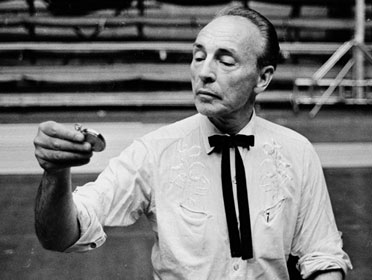
17 October 1933: The day George Balanchine arrived in New York City marks the start of the experimentation which would evolve in Balanchine’s American neo-classicism. His modernist re-shaping of the nineteenth-century classical style made his company, the New York City Ballet, one of the most stimulating in the world.
The Rules
‘The art of progress is to preserve order amid change and to preserve change amid order’. This statement by the mathematician and philosopher Alfred North Whitehead is a perfect distillation of Balanchine’s contribution to ballet. He bent, but never abandoned rules. The classical ballet vocabulary which had accrued since the time of Louise XIV was Balanchine’s bedrock, Marius Petipa his fountainhead.
Chaos
The death of Serge Diaghilev in 1929 had thrown the ballet world into chaos. He had so completely dominated ballet for the two previous decades that no one quite knew where to turn. Various individuals made attempts to keep the Ballets Russes together. These offshoots were quickly reduced to factions who bickered over billing, copyright and personal allegiances. For decades the general public continued to believe that the only great dancers were Russian, and even after Diaghilev (though less frequently), performers changed their names to something which sounded Russian, or at least exotic.
Two Women Find the Way Forward
It was in England that a pair of percipient women, who had both performed with the Ballets Russes, realised that the way forward could to be found by building on Diaghilev’s legacy rather than attempting to ape his past successes. Marie Rambert and Ninette de Valois lured Alicia Markova back to London and then were content to let the Continental upheavals pass them by.
This was less a case of insularity than a determinedly single-minded policy aimed at creating a British ballet that would be second to none. Fate brought them Frederick Ashton, Margot Fonteyn, Antony Tudor – and Nicholas Sergeyev, the former general director of the Maryinsky (now Kirov) Theatre. When he fled the October Revolution, he had packed his cases with his notations of the nineteenth-century classics. With these enduring works, rather than the more transient ballets of the Diaghilev repertory, young British dancers and choreographers were presented with an ideal barometer for their creations.
Upsurge
Across the Atlantic, Balanchine was not the only choreographer with a vision of an American ballet. In the 1940s, there was an upsurge in Americana themes: the most popular of these, Agnes de Mille’s Rodeo, was (ironically) premiered by the Ballet Russe de Monte Carlo, which had emigrated to America to avoid the European upheavals of Second World War. The high-profile debut of Ballet Theatre (later American Ballet Theatre) in 1940 was on a grand scale. The company’s goal was to reflect a broad-based melting pot of the classic and the new, from Giselle to the riotously popular Fancy Free, staged with modern flash by Jerome Robbins in 1944.
Balanchine’s Ensemble
Meanwhile, Balanchine kept beavering away, refining and polishing, and above all nurturing the first generation of dancers trained to dance his way. The opening of an academy, the School of American Ballet, had been his priority on arriving in New York. By 1946, when he and his associate Lincoln Kirstein unveiled their Ballet Society, the raw talent of 1933 had been shaped into the speedy, articulate and musically sensitive ensemble that Balanchine had come to America to create.
The Superdancer
Not all modern ballet was allowed to look forward. In the USSR, staunch conservatism kept new ideas at bay. Politically restrained from experimentation with content, the Russians turned to context: the ballet dancer’s body. Moving almost as far from Petipa as Balanchine (though in the opposite direction), the Soviets began to develop the superdancer, an athlete capable of virtually anything. Their teaching systems sometimes seemed to be stressing acrobatic displays of physicality for its own sake, but there was no doubt about the excitement generated by the virtuosity of such daredevils as Maya Plisetskaya, Vladimir Vasiliev, Maris Liepa and eventually Rudolf Nureyev, the man who would bring Russian bravado to the West.




